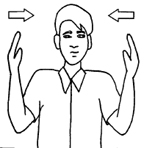Bulletin #2335, Maine Farm Safety Program: Hand Signals Useful for Farmers

Bulletin #2335, Maine Farm Safety Program: Hand Signals Useful for Farmers (PDF)
By Dawna L. Cyr, Farm Safety Project Assistant, and Steven B. Johnson, Ph.D., Extension Crops Specialist
Illustrations by Jennifer W. Johnson
For information about UMaine Extension programs and resources, visit extension.umaine.edu.
Find more of our publications and books at extension.umaine.edu/publications/.
Workaround either field or farms machinery is apt to be noisy and, if more than one worker is involved, risky as well. Communication between workers is essential to avoid confusion and possibly an accident.
For many years, hand signals have been used by the military, construction workers, and factory laborers in communicating when voice communications are impossible or apt to be misunderstood. Uniformity in signaling is essential when many people must work together doing hazardous jobs.
- Train employees in hand signals useful for agriculture.
- Know hand signals useful for agriculture.
You probably use more signals than you realize. However, uniformity is the key point and reason enough to get the farm crew together for a training session.
One person should study and learn the signals beforehand. This person will demonstrate them accurately and explain the circumstances when they are to be used. Each person, including family members, should have the opportunity to practice the signals. After learning the signals, use them whenever you can under real working conditions.
The following signals were developed by the Indiana Farm Safety Council, refined by the National Institute for Farm Safety and then adopted by the American Society of Agricultural Engineers as ASAE Standard ASAE S351, Hand Signals for use in Agriculture.









This Maine Farm Safety fact sheet is part of an educational fact sheet series produced by University of Maine Cooperative Extension. For more information on farm safety, contact your UMaine Extension County Office.
Information in this publication is provided purely for educational purposes. No responsibility is assumed for any problems associated with the use of products or services mentioned. No endorsement of products or companies is intended, nor is criticism of unnamed products or companies implied.
© 2002, 2020
Call 800.287.0274 (in Maine), or 207.581.3188, for information on publications and program offerings from University of Maine Cooperative Extension, or visit extension.umaine.edu.
In complying with the letter and spirit of applicable laws and pursuing its own goals of diversity, the University of Maine System does not discriminate on the grounds of race, color, religion, sex, sexual orientation, transgender status, gender, gender identity or expression, ethnicity, national origin, citizenship status, familial status, ancestry, age, disability physical or mental, genetic information, or veterans or military status in employment, education, and all other programs and activities. The University provides reasonable accommodations to qualified individuals with disabilities upon request. The following person has been designated to handle inquiries regarding non-discrimination policies: Director of Equal Opportunity, 5713 Chadbourne Hall, Room 412, University of Maine, Orono, ME 04469-5713, 207.581.1226, TTY 711 (Maine Relay System).

